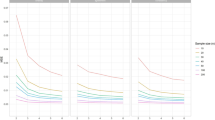Abstract
Over the last two decades, there has been growing interest in comparative performance evaluation of health institutions. Small hospitals and small nursing home facilities might have too few eligible cases for sufficiently precise comparisons in a single year (or other standard reporting period). An analyst might be tempted to use the smaller standard error estimates obtained under the finite population sampling model (FPSM), rather than those obtained under a superpopulation model. We argue that the FPSM does not properly represent the reliability of quality profiling information in such situations . We consider alternative methods for obtaining adequately precise profiles for small institutions, including moving averages and hierarchical models.
Similar content being viewed by others
References
Birnbaum, D.: Who is at risk of what? Infect Control Hosp Epidemiol, 20, 706–707 (1999)
Brillinger, D.R.: The natural variability of vital statistics. Biometrics 42(4), 693–712 (1986)
Goldstein, E., Cleary, P.D., Langwell, K.M., Zaslavsky, A.M., Heller, A.: Medicare managed care CAHPS: a tool for performance improvement. Health Care Financ. Rev. 22, 101–107 (2001)
Goldstein, H., Spiegelhalter, D.J.: League tables and their limitations: statistical issues in comparisons of institutional performance. J. R. Stat. Soc. [Ser A] General 159, 385–409 (1996)
Hargraves, J.L., Hays, R.D., Cleary, P.D.: Psychometric properties of the Consumer Assessment of Health Plans Study (CAHPS) 2.0 Adult Core survey. Health Serv Res 38, 1509–1527 (2003)
Keyfitz N.: Sampling variance of standardized mortality rates. Human Biol. 38, 309–317 (1966)
Kish L.: Survey Sampling. John Wiley and Sons, New York (1985)
New York State Department of Health AIDS Institute 2004. The HIV Quality of Care Program. New York: NYSDOH AIDS Institute. Accessed July 23, 2006 http://www.hivguidelines.org/public_html/qoc–program/qoc-program-book-04.pdf
Zaslavsky, A.M.: Statistical issues in reporting quality data: small samples and casemix variation. Int. J. Qual. Health Care 13, 481–488 (2001)
Zaslavsky, A.M., Schirm, A.L.: Interactions between survey estimates and federal funding formulas. J. Off. Stat. 18, 371–391 (2002)
Zaslavsky, A.M., Zaborski, L.B., Cleary, P.D.: Plan, geographical, and temporal variations of consumer assessments of ambulatory health care. Health Serv. Res. 39, 1467–1486, (2004)
Acknowledgements
The work reported in this paper was conducted as part of the CAHPS II project and funded by the Agency for Health Care Quality and Research (AHQR) and the Health Care Financing Administration through cooperative agreements with Harvard Medical School (HS09205) and RAND (HS00924). The authors thank project officers Chris Crofton, Chuck Darby, Beth Kosiak, and Marybeth Farquhar for their active participation and helpful suggestions throughout the project and members of the CAHPS consortium for their role in the design and implementation of the data collection activities. The authors would like to thank Dan McCaffrey, Ph.D. for his comments on an earlier version of this manuscript and Colleen Carey, B. A. for her help in the preparation of the manuscript.
Author information
Authors and Affiliations
Corresponding author
Rights and permissions
About this article
Cite this article
Elliott, M.N., Zaslavsky, A.M. & Cleary, P.D. Are finite population corrections appropriate when profiling institutions?. Health Serv Outcomes Res Method 6, 153–156 (2006). https://doi.org/10.1007/s10742-006-0011-2
Received:
Revised:
Accepted:
Published:
Issue Date:
DOI: https://doi.org/10.1007/s10742-006-0011-2




